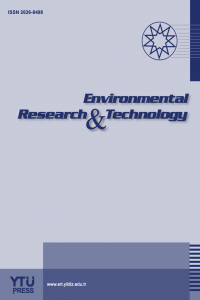Life cycle assessment of an office: Carbon footprint of an office staff
Life cycle assessment of an office: Carbon footprint of an office staff
Environmental problems have become today’s most emphasized issues due to the unconscious use of natural resources and the ongoing increase in consumption resulted in an increased level of environmental pollution. Offices, where most of the daily time is being consumed in today’s modern world, generate the important amount of daily wastes and increase the environmental burden. In this respect, it is important to investigate and to reveal their environmental impacts. In this study, the Organizational Life Cycle Assessment (O-LCA) of an office has been conducted in order to investigate the environmental impacts caused by a typical office and to reveal carbon footprint of an office staff. The water and energy consumption (electricity and natural gas), transportation, and business travel data were obtained based on the real consumptions of the organization, while data required for the calculation of the waste amount (paper, cardboard, plastic etc.) were provided from literature. Afterwards, data obtained for office have been run into SimaPro Analyst 8.0.2 software in order to calculate carbon footprint and to analyze the environmental impacts. As a result of the calculations made, the carbon footprint of the office has been found as 105 kg CO2-eq year-1 and the carbon footprint of an office staff has been determined as 5263.16 kg CO2- eq year-1, accordingly. The obtained results have indicated that the highest share in terms of carbon dioxide emission is caused by electricity consumption, followed by transportation, business travel, office consumables, electronic devices, natural gas consumption, office wastes, water consumption, and electronic wastes, respectively.
___
- Reference1 : A. Güngör, Y. İkiz, S. Palamutçu, G. Gören, G. Ağırbaş and O. Polat, “Çevreye duyarlı bakış açısı ile tekstil ürünlerinin yaşam döngülerinin analizi” (in Turkish), Tübitak Project Result Report, Project No: 104M376, Denizli, Turkey, 2007.
- Reference2 : S. Junilla, A. Horvath and A. Guggemos, “Life cycle assessment of office buildings in Europe and the United States”, Journal of Infrastructure Systems, 12(1), 10-17, USA, 2006.
- Reference3 : D. Clark, “CO2 emissions due to office waste”, Information Paper-6, What Colour is Your Building, England, 2013.
- Reference4 : Turkish Standard Enstitute (TSE), “ISO 14044 Environmental management – Life cycle assessment –Requirements and guideline”, 2007.
- Reference5 : United Nations Environment Programme (UNEP), Society of Environmental Technology and Chemistry (SETAC) and Life Cycle Initiative, “Guidance on organizational life cycle assessment”, 2015.
- Reference6 : National Environment Agency. “Waste and Recycling Statistics for 2016,” Available: http://www.nea.gov.sg/energy-waste/waste-management/waste-statistics-and-overall-recycling (accessed 18.09.2017).
- Reference7 : European Aluminium, Aluminium beverage can recycling at 73%, Press release, Brussels, Nov. 2017. Available: https://www.european-aluminium.eu/media/1988/european-aluminium-press-release-2014-can-recycling-result-7nov2017_final.pdf (accessed 18.09.2017).
- Yayın Aralığı: Yılda 4 Sayı
- Başlangıç: 2018
- Yayıncı: Yıldız Teknik Üniversitesi
Sayıdaki Diğer Makaleler
Decolorization of Reactive Orange 16 and Reactive Black 5 in aqueous solution by ozonation
İrem ONDER, Okan AYDİN, Afife GUVENC
Adsorption of Remazol Brilliant Blue R by raw and carbonized macroalgal wastes
Anil Tevfik KOCER, Benan INAN, Didem OZCİMEN
Recycling posibilities of packaging wastes - the case of Kırıkkale
Oylum GOKKURT BAKİ, Ozan PARLAK
Removal of Cu (II) from wastewater of metal coating process by borax sludge
Esma Burcu RONA, Meral YİLDİRİM OZEN, Emek MOROYDOR DERUN
Life cycle assessment of an office: Carbon footprint of an office staff
